“Vida” Review: Starz’s New Latinx Drama Is Sexy, Soulful and Super Queer
“Yet, in leaving home I did not lose touch with my origins because lo mexicano is in my system. I am a turtle, wherever I go I carry ‘home’ on my back.”
Those words are from Chicana lesbian feminist poet and scholar Gloria Anzaldúa’s most famous work, Borderlands/ La Frontera. Borderlands is in part a meditation on being Chicana, being Mexican-American, being from multiple homes that often feel at war with each other, and never quite belonging to each. Watching Tanya Saracho’s Vida, which explores its own set of questions about the difficulties of home and belonging from the eyes of a queer Chicana, I couldn’t help but be brought back to Anzaldúa — What does it mean when you end up back in the home you once ran from? What new lessons await you there?
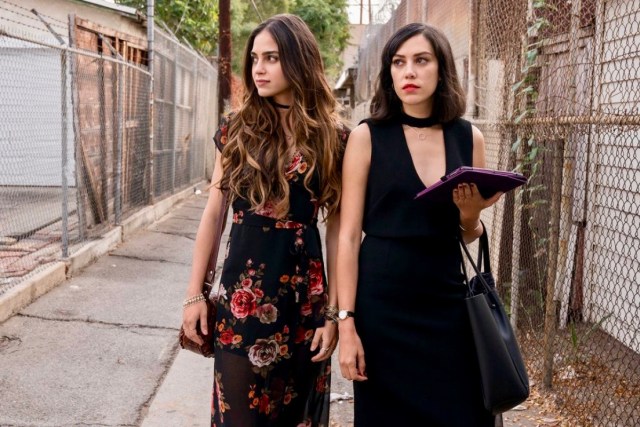
Lyn Hernandez (Melissa Barrera) and Emma Hernandez (Michel Prada)
Vida follows two adult sisters, Emma Hernandez (Michel Prada), the queer protagonist in question, and Lyn Hernandez (Melissa Barrera). The sisters are returning home to their Boyle Heights, East Los Angeles neighborhood following the death of their mother. After years estranged from each other, their mother, and their home, Emma and Lyn are hoping to make a quick funeral appearance and get out of town. Things immediately get more complicated when the two sisters meet Eddy (out queer non-binary actor Ser Anzoategui), their mother’s handsome, quietly shy, butch lesbian “roommate” who they find out at the funeral was actually her wife.
Forced to confront their mother’s secret marriage and readjust to their old childhood neighborhood, ghosts from the past blow in like the breeze to haunt both sisters. Emma catches up with her first girlfriend, Cruz (Maria Elena Laas). Their relationship — along with her mother’s death — opens up pain that Emma once thought she buried. Lyn finds herself in a similar messy path down memory lane with her old high school boyfriend, Johnny. Eddy, the softest of butches to ever soft butch, works to make a home for both girls, despite her own grief and their collective icy first meeting. Framing the central family drama, Boyle Heights becomes a character of its own, with Marisol — Johnny’s teenage community activist younger sister — serving as its protector.
In 2016, after a successful career as a playwright and several years experience in the television writers rooms of network and cable hits such as HBO’s Looking and Girls, along with ABC’s How to Get Away with Murder, queer writer/producer Tanya Saracho was approached by Starz. They were interested in developing a series about gentrification in East LA.
They gave her an article about “gente-fication.” The term refers to when historically Chicanx and Latinx neighborhoods are gentrified or otherwise redeveloped by younger, middle and upper middle class Latinxs. They have a nostalgia for their old communities, but also want Starbucks and Wi-Fi. They also have little consideration for the disruption that their upwardly mobile presence causes and the resulting long term consequences for the poor and working class residents who already live there. Saracho was drawn to the racial and class complexities of the article, but as she told Out Magazine, she also felt that “it had nothing about queerness and women… So I was like, I’m going to make it my thing”.
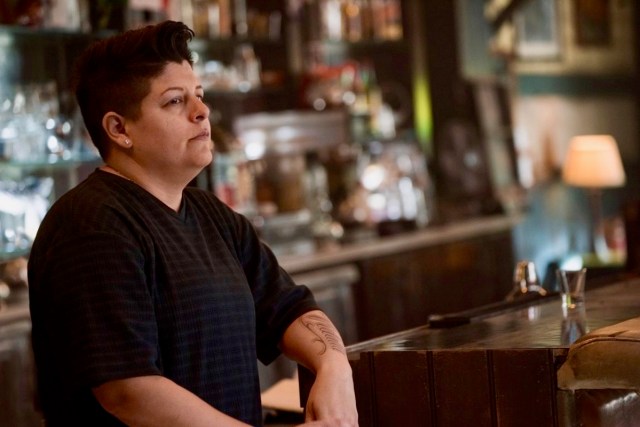
Eddy (Ser Anzoategui)
Her thing is Vida, developed by Saracho and brought into fruition with the help of an entirely Latinx, mostly queer, writers room, along with a team of people of color directors. Over the six episodes of its first season, Vida takes not only gentrification and class discrimination to task, but also homophobia and sexism. It pays tribute to the communities that women build with each other to save ourselves. Those threads are woven into the scaffolding of a sultry, deeply moody, expertly detailed exploration of family, sex, grief, love and rediscovery.
Vida’s half hour format makes it easily digestible, but it would be a mistake to think of it as mindless as a result. Saracho’s skills as a playwright are at the forefront here — the show moves at its own pace. It’s richly soulful and plenty addictive, but it also takes a few episodes to really pull back the layers of the characters. If you’re willing to traverse the journey, the results will blow you away. Each of Vida’s episodes stayed with me long after the show ran its credits. I’d hear Emma or Lyn’s voice in my ears; I would close my eyes and see Eddy’s in return. The women of Vida burrow into your heart and soul.
Proudly rooted in Chicanx and Latinx storytelling, Vida doesn’t shy away from mysticism or playing with Gabriel García Márquez’s magical realism. The characters fluidly swing in and out of their Spanglish. They share in memories of Selena and eat Mangonadas with fresh chili on top. They don’t patiently hold their audience’s hand through the experience, either. But, Saracho and rest of the show’s writers are not making Vida limiting to outsiders. Instead, they ask that viewers engage the show on its own terms. It’s brazen and a bit bold in that way — asking that you bring all of yourself to the viewing process, and it promises to be vulnerable enough to give all of itself in return.
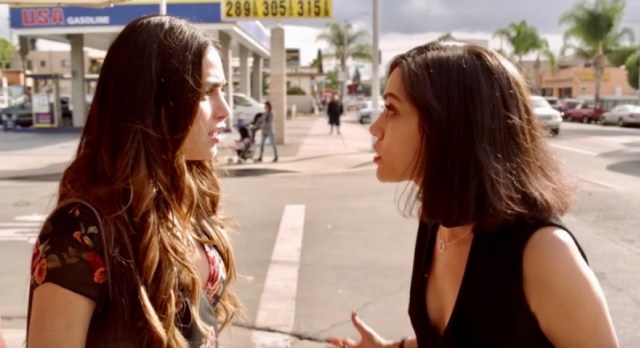
Vida’s super sexy and unapologetic in its queerness. The queer sex doesn’t happen right away, but when it shows up, it announces itself with a BANG that will be heard ‘round the world. Though Emma and Eddy are the central queer protagonists, the supporting cast of each of their friendship circles come peppered with queer bodies of all shapes and sizes and gender spectrums. Ser Anzotagui explained it best to Autostraddle, “they talk like my real life friends. More than once I got lost in the background conversation, and found myself answering back.” Cruz, straddling the line of being both Emma’s old flame and newly acquired love interest, can’t help but stand out from that pack. Her swag can be seen from space — and her shoulder tattoo sleeve definitely didn’t hurt.
A family of women opening up their baggage and helping each other heal their scars, a community not turning a blind eye to their surrounding politics, and queerness as the central axis upon which everything else spins — it’s everything I could want out of my viewing schedule for the next six weeks.
If you want to catch up with Autostraddle’s Vida coverage ahead of the show’s debut this weekend, I’d recommend our interviews with both Ser Anzoategui and Tanya Saracho, who were open hearted, brutally honest, and just flat out delightful in their time with us.
Vida premieres this Sunday, May 6th, at 8:30 PM, wherever you have Starz.


Vida’s Non-Binary Latinx Actor Ser Anzoategui Already Knows Their Show Will Be Your New Favorite
Starz’s new half hour drama Vida premieres this Sunday, May 6th. If you haven’t caught up with buzz yet, now is the time! We feel pretty confident that you’re going to love it.
Writer/Producer Tanya Saracho (Looking, How To Get Away with Murder) has crafted the kind of show that I’ve been waiting for years to come to us. She wanted an all-Latinx writers room — so, she made it happen. She wanted the writers to be heavily queer — so, she made it happen (50% of the writers identify as LGBTQ+). She wanted every director on the show to be either a woman of color or Latinx — so, she made it happen. From the bottom up, in every nook and cranny, this show was built with queer folks, Latinxs, and people of color in mind.
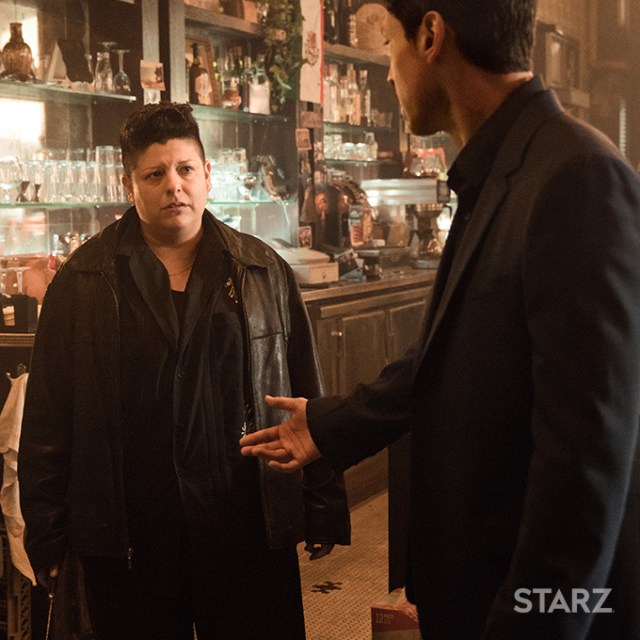
Eddy played by Ser Anzoategui. Photo courtesy of Starz.
On top of all of that already amazing production news, Vida is just some really great television! It is moody, sultry, thoughtful, political, funny as hell, and addictive in all the best ways. It’s the exact kind of show you want going into your summer.
Vida explores the journey of two estranged Chicana sisters, Lyn and Emma, as they return home to their old neighborhood in East LA following their mother’s death. One of the sisters, Emma, is queer, but has a complicated relationship to her sexuality. Both sisters get a major surprise when they find out that for the last years of her life, their mother was married to a woman. Her widow is Eddy, the sensitive butch bar owner, a handyman stud with soft eyes and a big heart who is going to wrap you all around her pinkie finger.
Eddy’s portrayed by out non-binary actor Ser Anzoategui. They’re a theatre and screen actor with over a decade in the business, and an activist invested in Latinx and Chicanx communities, trans and queer folks, and fighting against the gentrification of East LA.
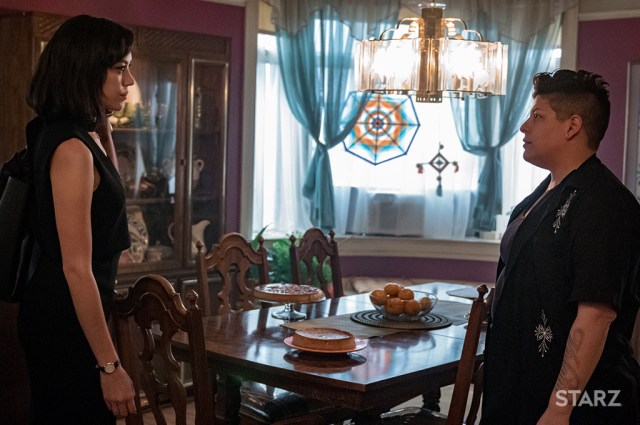
Emma and Eddy. Photo courtesy of Starz.
Starz is very invested in Autostraddle’s community finding this show, so they’ve given our team a lot of access to Vida ahead of its premiere. We’ll have an interview with Tanya Saracho later this week and a full review of Vida, but let’s get started with an awesome one-on-one interview with Ser!
Carmen Phillips: Let’s get to it!
Autostraddle’s readers are primarily feminist, queer women and non-binary folks. As a writing staff, we’ve been hyping up Vida for months! Now that we are so close to the show’s premiere: If you had a magic microphone that could reach out to all the queer people in the land, what would you want them to know about their new favorite TV show Vida?
Ser Anzoategui: It’s everything they ever wanted, plus new fantasies! It’s amazing, and addictive. You’re going to want more and more. It’s something that finally feels real.
It’s unapologetic in the way that it’s told. It’s told through a femme — I prefer femme to female — gaze. It’s also very queer-centric. You see them hanging out with friends and they’re all of different identities. And they talk like my real life friends. More than once I got lost in the background conversation, and found myself answering back. I would just go there for a second.
Also, the way it’s shot is so exciting! It’s great to see someone like Rose Troche (a lesbian Puerto Rican filmmaker) direct episodes four and six, and make such great creative choices on how to best tell a queer story.
And THE SEX! The way that they shot the sex! It’s very queer.
Carmen: YES! And I have to say, the sex in Vida is unlike anything that I’ve ever seen. I had the opportunity to watch the screeners and I was just… mind blown might be an understatement.
Ser: Hearing that coming from you means a lot. You know, we have different stories than The L Word. When you see those shows, you don’t see Latinas. I mean there’s Carmen —
Carmen: Yeah, there’s Carmen. And there’s Papi. And honestly, neither of them were even played by Latinas.
Ser: Oh, woooooow. They’re not… wow… I hadn’t even thought about that.
Carmen: That’s a whole other conversation. I’m so sorry to drop that on you —
Ser: Well, you know what? Now I’ll say it. They were both non-Latinas playing Latinas. And I love Janina Gavankar. I love her. Back then I was all like, “Whew! Papi!”
So back to Vida. It’s real, and raw. It’s sexy. It lets you behind the velvet rope in the room. It’s multilayered, especially if you watch it more than once. When you watch the series, you’re going to want to watch it again.
Carmen: Your depiction of Eddy stood out for me right away. It’s going to be one of the most memorable performances of the year. What was the process of crafting her character like for you?
Ser: Thank you for that. Tanya Saracho is also an actress, so she just laid Eddy all out for me.
When I was on set, I got a taste of what it would mean to sustain that level of performance for twelve hours at a time. I had to continue to be in the world of grief and love — at the drop of the dime, I had to be able to cry my eyes out. So, I needed to keep focus. I did that by using a lot of background improv.
For one scene, I asked Adelina Anthony, who’s also a wonderful Latinx, queer, two-spirit playwright and performer, “Yo, please! Help me out!” and together we just started improving around set — with the bartender, the extras. We just kept connecting for hours! After a while, you start to let go! You just start to transcend into your character. I didn’t even know we were filming at some points. I was in the zone. I was allowed to just go places. I was told, “Just keep going! Just be.”
I feel like I can take on anything, after doing Vida.
Carmen: I love that Eddy is really rooted in her neighborhood. Often when we’re told stories about queer Latinidad, it’s about of strife and isolation. Vida gets into those themes, but Eddy’s clearly at home in her building — and with her gente. She has a great relationship con las doñas (a Spanish term of respect for older Latina women). That’s so real to the Latinx community that I know and love.
You don’t often see a younger queer character embraced by community elders on screen. How was it for you to play out those relationship dynamics?
Ser: In my own life, I have so many relationships with older people. We just find an instant love with each other — we find a tender, loving relationship. It’s not something that gets clouded or judged or torn apart by gender identity.
It’s a beautiful thing to bring to life on screen! A character who has these relationships. Eddy brings people together. She’s trusted by people you wouldn’t think would trust her, you know? Like Doña Tita (a character on the show).
Doña Tita is the best! And did you know that Renee Victor also voiced the grandmother in Coco? I loved acting with her. She has such experience. I’ve known her work, and to actually get to do scenes with her? It was really huge. She kept cracking me up! Eddy needs Doña Tita. The doñas — they’re there to help, to heal you, to cook food.
Carmen: You’ve talked a bit about your relationship with others in the cast. Something that’s really excited us about Vida is that the production team behind it — the directors, producers, writers — were purposefully designed with queer Latinxs in mind. I wondered if, as an actor, that atmosphere made a difference for you?
Ser: You can feel it. When you walk on set you can feel the warmth, the electricity, the vibe. It’s almost in the air! I think when you get the freedom of, “Yeah you can do it! You can go for it!” — now you can see the possibilities. We don’t know the possibilities until they happen.
The space that Vida is cultivating allows for more understanding and conversations than you otherwise would have with producers. After years and years of Hollywood being run a certain way, now we are seeing things being made the way they should be. The network is saying, “Let’s trust our showrunner. Let’s trust the people who know our audience best.”
And [Tanya Saracho] is very detailed. She’s very particular. But, she’s also very loving as she decides, “Okay — who is going to be on our team? What is the right energy?”
https://www.instagram.com/p/BgKSVCLDZw8/?taken-by=ser_anzoategui
Carmen: That leads into my next question! A lot of our readers are going to remember you as the gender non-confirming, queer character Daysi Cantu from East Los High. It’s been riveting to watch your growth as an actor. I feel like queer Latinx representation in Hollywood is still not seen or heard enough. As a television critic, I’m hopeful this is changing. I wondered how your experience in Hollywood has been in these last few years as an out, non binary, Latinx actor?
Ser: Well, I feel like it’s a progression. It’s working on many levels — on producing, on storytelling, the arts of cinema and camera work, the writing, the casting. [As it relates to Vida], Tanya is spearheading a lot.
That leadership made a difference when filming on location. And it’s something that we talked about! Because I know my community in Los Angeles. I wondered, how are we going to film this? But [Tanya] was open. She wanted to embrace community building; listening and tuning in without becoming invasive or intrusive to the neighborhood.
We listened to the activists. We avoided shooting on the Eastside whenever possible. We shot on set. It’s not only about the story. It’s about the respect of how you tell the story. It’s how you treat your neighbors. It’s understanding that if the activists or the community are saying, “we don’t want you there” — then you don’t go there.
I also think it’s important to show that queer and trans folks are the heads of these movements!
I think it’s really important that we’re brown, and that we’re different identities, multiple identities. It’s important to show that there’s undocuqueers, that there’s fat positivity, there’s Chingona Power. That we’re reclaiming Chingona back from being a being a bad word. It’s a powerful word. And we’re going to own it.
Carmen: Absolutely! Yaaaas! Absolutely. I love it. You’re giving me real strong Sandra Cisneros vibes.
Ser: Right!?!?
Carmen: Ok, so I know our time is limited. I’m going to end with something fun. When doing research for this interview, I came across a recent Instagram post you made honoring the anniversary of the Selena’s passing (the Tejana Latinx icon passed away on March 31st, 1995 — a date often honored by her fans online).
Ser: Oooh! She’s in it, too! She’s in Vida.
https://www.instagram.com/p/BhAnbbyjVyZ/?taken-by=ser_anzoategui
Carmen: Yes! Selena’s in Vida. I was thinking about how it’s crazy we lost her so long ago. In your post, the way you described connecting to Selena as a young person really caught my attention. When I was a kid, I would play Selena’s “Dreaming of You” in my room for hours. And I definitely felt her spirit in the room with me.
I was curious, what is your favorite Selena song? And why?
Ser: [A thoughtful breath before breaking out in impromptu song] — ?? “Si una vez dije que te amaba, hoy me arrepiento/ Si una vez dije que te amaba/ No sé lo que pensé, estaba loca…”? ?
Carmen: Oh my god! Okay… Wow. That was PERFECT!! I only wish I could include the live recording of you singing for our readers.
Thank you so much for taking this space with us. We really appreciate it. I cannot tell you how excited I am to keep banging the drums about Vida. You guys are doing great!
Ser: Yes! Let’s keep it going! I’m excited that you’re excited. Thank you to Autostraddle. I really appreciate all the support, and the love. I’ll never forget it!
Vida debuts this Sunday, May 6th, on Starz. We also spoke with its queer showrunner Tanya Saracho ahead of the show’s premiere. Check out the trailer below for Vida and follow Ser on Twitter and Instagram to keep up with them through season one.
https://youtu.be/c0ttPSaqhF0